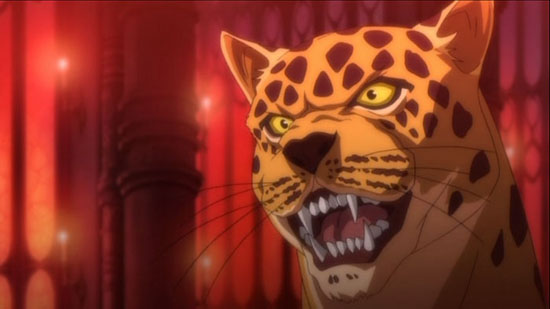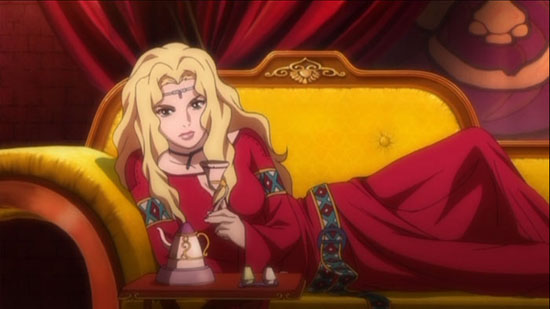
It’s kind of interesting to look at the variety of high fantasy anime out there. Considering that the whole high fantasy deal is usually a very, very western affair, you’d think that the stuff from Japan would tend to be obviously Japanese, or at least obviously of Asian origin. And sure, a lot of is like that—stuff like Moribito, and The Twelve Kingdoms, for example—but Japan has been just as eager to use the western version of swords n’ sorcery, wizards and warriors, and mazes and monsters as a jumping-off point. A college kid named Ryo Mizuno turned his Dungeons and Dragons campaign into the impressive and robust Record of Lodoss War. Slayers, a popular anime series about a bad-tempered sorceress and her crew of idiots, originally came from lavishly illustrated novels. But the unquestioned champ of literary high fantasy in Japan is Guin Saga, a decades-in-the-making epic spread out over more than a hundred short novels. Sooner or later, this thing—which, I might add, is available in novel and comics form from Vertical—was going to make the jump to the screen. At first glance, it seems to have done just fine with the trip—this 26-episode TV series was produced by Aniplex and animated by Satelight, with snappy character designs by Toshiharu Murata (Hellsing, Batman: Gotham Knight) and music by none other than Nobuo Uematsu, the guy behind the Final Fantasy music. I think the problem must be the director, Atsushi Wakabayashi, a guy known for really good storyboards and key animation; Guin Saga is the first time he’s sat in the director’s chair and led a team, and it shows.
The show’s opening act feels like every great fantasy story ever written—a proud kingdom is under siege from jealous neighbors, the royal twins are spirited away from the battle front, and they end up making their escape through a thoroughly inscrutable magical device. The invaders, the Mongoul Empire, want to use this invention, and they’re convinced that Prince Remus and Princess Rinda of the kingdom of Parros are the key to its use, so they immediately start searching for the pair. The silver-haired Remus and Rinda quickly run afoul of Mongoul soldiers, who are shocked to find them so far from Parros, but they also find something else—a hulking, towering man named Guin. Guin has no memories, can only really remember one word – ahura – and he really doesn’t like it when big, mean guards gang up on shrimpy little defenseless nobles. Also, he wears a leopard mask over his entire head.

Guin is completely awesome. He’s like this outrageous fusion of Conan the Barbarian, He-Man, Lion Maru, and goddamn Tiger Mask. He ends up killing about two dozen bad guys in full armor while clad only in a loincloth and armed with a sword that looks about three sizes too small for him. He’s rattled, but curiously accepting of his strange circumstances; not only is he kind to and protective of Rinda and Remus, he’s also apparently stuck with the mask on—it doesn’t come off, and the twins are vaguely disturbed when they take a close look and realize that it probably isn’t actually a mask—the eyes peering out of the head are unquestionably the hungry yellow peepers of a predator. Guin isn’t totally invincible, though, and a bunch of guards from a nearby Keep are able to outflank him. That’s fine, though, because it allows the Guin Gang to get another member from the jail—the laconic mercenary Istevan Spellsword (awesome name!)—and permits Guin to square off against a powerful dark magician.
See, as long as there’s fighting happening, Guin Saga is pretty good, or at least serviceable. You can tell right away when the director is animating the cut himself, because the animation suddenly goes from lousy to kind of awesome—Wakabayashi is great at conveying action and fast, exciting movement, so in that respect, he was a good fit. As Guin and company get the hell out of Mongoul and head towards the shadowy land of Nospheros via the treacherous River Kes, they are pursued by the ambitious Amnelis, a royal princess of Mongoul, and her retainer Marus, who’s the only swordsman in the entire damn 13-episode arc that can give Guin any trouble at all. So there’s a chase scene, and there’s some fighting, and Guin and his pals get rescued by the Sem, a tribe of monkey-like folk who kind of resemble Monchichis (anyone remember those?). This is where they finally remember to use the cool part of the “amnesiac badass” character and reveal that Guin somehow knows the aboriginal tongue of the Sem, but sadly, they don’t reveal too much else about Guin’s past or his retinue of skills. Amnelis pursues our heroes doggedly but is defeated at every turn by a guerilla (ha!) army of Sem warriors carefully directed by Guin, who’s also a master tactician; meanwhile, Istevan quietly infiltrates and double-crosses the Mongoul leadership.

It sounds pretty good, doesn’t it? Like I said, when Guin Saga is all about swordfighting and outflanking and giant waves of flaming arrows, it’s better than decent. The problem is, at least half of the show is characters standing around and talking, to try and keep the story going and the viewer from getting too confused. Unfortunately, coming from a guy who read the first couple of Guin books, they totally dumbed down most of the characters and story bits, and even the stuff they kept is often left inexplicably unexplained. Guin is able to break the back of the Mongoul expeditionary forces chasing him by bringing together the aboriginal tribes of the region, but he never stops to talk about why this is all happening or how most of the characters relate to each other. It doesn’t kill the story, but it makes it way less immersive. Another big problem with Guin Saga is that right at the end of this first half are two really talky, stand-around-y episodes about intrigue in the royal court, as Amnelis is called back and punished for her failure by being tossed into an arranged marriage with the only remaining Parros nobleman, the captured Duke Norisse.
Guin Saga isn’t bad. I like the main character a lot—he’s tough but not invincible, and weird but still compelling—one of my favorite bits in this set involves him easily squashing a haughty, boastful swordsman from the Mongoul side, only to snarl, “Let me make this clear – you are no challenge to me!” and then refusing to waste any time killing the jackass. But there isn’t really enough story here, and the non-action stuff sometimes literally hurts to look at (if you watch this show, look at the horse animation—they just can’t freakin’ do it!). The celebrated Uematsu’s music is nice but devoid of any uniqueness; he could’ve paired it with any old Final Fantasy and nobody would have noticed. Maybe the series improves dramatically in its second half, but as it stands, this is strictly watch-if-it’s-on-TV fare. Guin Saga would make a really premium 90-minute TV movie deal, but as the 325-minute-long first half of a 26-episode TV series, it’s all stretched out like taffy, and like taffy, it’s a real pain in the butt to chew through.

